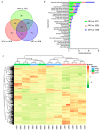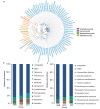Longitudinal Distribution Map of the Active Components and Endophytic Fungi in Angelica sinensis (Oliv.) Diels Root and Their Potential Correlations
- PMID: 38248851
- PMCID: PMC10821059
- DOI: 10.3390/metabo14010048
Longitudinal Distribution Map of the Active Components and Endophytic Fungi in Angelica sinensis (Oliv.) Diels Root and Their Potential Correlations
Abstract
The three distinct medicinal parts of Angelica sinensis (Oliv.) Diels (Ang) roots are the head, body, and tail (ARH, ARB, and ART, respectively). How endophytic fungi shape the differences in metabolic components among these parts remains unclear. We quantified the distribution of active components and endophytic fungi along the ARH, ARB, and ART and their relationships. Based on the metabolic components and their abundances detected via non-target metabolism, the different medicinal parts were distinguishable. The largest number of dominant metabolic components was present in ART. The difference between ART and ARH was the greatest, and ARB was in a transitional state. The dominant active molecules in ART highlight their effects in haemodynamics improvement, antibacterial, anti-inflammatory, and hormone regulation, while ARH and ARB indicated more haemostasis, blood enrichment, neuromodulation, neuroprotection and tranquilisation, hepatoprotection, and antitumour activities than that of ART. The ARHs, ARBs, and ARTs can also be distinguished from each other based on the endophytic fungi at the microbiome level. The most dominant endophytic fungi were distributed in ART; the differences between ART and ARH were the largest, and ARB was in a transition state, which is consistent with the metabolite distributions. Structural equation modelling showed that the endophytic fungi were highly indicative of the metabolic components. Correlation analysis further identified the endophytic fungi significantly positively correlated with important active components, including Condenascus tortuosus, Sodiomyces alcalophilus, and Pleotrichocladium opacum. The bidirectional multivariate interactions between endophytic fungi and the metabolic components shape their spatial variations along the longitudinal direction in the Ang root.
Keywords: Chinese Angelica; active metabolic components; association analysis; different medicinal parts; endophytic fungal communities; spatial variations.
Conflict of interest statement
The authors declare that there are no conflicts of interest.
Figures








Similar articles
-
Exploring the synergistic effects of soil nutrients, rhizosphere fungi, and endophytic fungi on the shaping of root metabolites in Angelica sinensis (Oliv.) Diels.Fungal Biol. 2025 Feb;129(1):101533. doi: 10.1016/j.funbio.2024.101533. Epub 2024 Dec 31. Fungal Biol. 2025. PMID: 39826984
-
The comparison of preliminary structure and intestinal anti-inflammatory and anti-oxidative activities of polysaccharides from different root parts of Angelica sinensis (Oliv.) Diels.J Ethnopharmacol. 2022 Sep 15;295:115446. doi: 10.1016/j.jep.2022.115446. Epub 2022 Jun 5. J Ethnopharmacol. 2022. PMID: 35675860
-
Succession of endophytic fungi and arbuscular mycorrhizal fungi associated with the growth of plant and their correlation with secondary metabolites in the roots of plants.BMC Plant Biol. 2021 Apr 5;21(1):165. doi: 10.1186/s12870-021-02942-6. BMC Plant Biol. 2021. PMID: 33820543 Free PMC article.
-
Danggui to Angelica sinensis root: are potential benefits to European women lost in translation? A review.J Ethnopharmacol. 2014 Feb 27;152(1):1-13. doi: 10.1016/j.jep.2013.12.018. Epub 2013 Dec 21. J Ethnopharmacol. 2014. PMID: 24365638 Review.
-
A Friendly Relationship between Endophytic Fungi and Medicinal Plants: A Systematic Review.Front Microbiol. 2016 Jun 9;7:906. doi: 10.3389/fmicb.2016.00906. eCollection 2016. Front Microbiol. 2016. PMID: 27375610 Free PMC article. Review.
Cited by
-
Unique tree: Foliar endophytic fungi of the critically endangered Andreadoxa flava (Rutaceae) in Brazil.Braz J Microbiol. 2025 Aug 13. doi: 10.1007/s42770-025-01757-z. Online ahead of print. Braz J Microbiol. 2025. PMID: 40802238
-
A Direct Relationship Between 'Blood Stasis' and Fibrinaloid Microclots in Chronic, Inflammatory, and Vascular Diseases, and Some Traditional Natural Products Approaches to Treatment.Pharmaceuticals (Basel). 2025 May 12;18(5):712. doi: 10.3390/ph18050712. Pharmaceuticals (Basel). 2025. PMID: 40430532 Free PMC article. Review.
-
An Update of Fungal Endophyte Diversity and Strategies for Augmenting Therapeutic Potential of their Potent Metabolites: Recent Advancement.Appl Biochem Biotechnol. 2025 May;197(5):2799-2866. doi: 10.1007/s12010-024-05098-9. Epub 2025 Feb 5. Appl Biochem Biotechnol. 2025. PMID: 39907846 Free PMC article. Review.
References
-
- Hou C.Y., Yin M.S., Lan P., Wang H.R., Nie H., Ji X.L. Recent progress in the research of Angelica sinensis (Oliv.) Diels polysaccharides: Extraction, purification, structure and bioactivities. Chem. Biol. Technol. Agric. 2021;8:1–14. doi: 10.1186/s40538-021-00214-x. - DOI
-
- Zhang H.Y., Bi W.G., Yu Y., Liao W.B. Angelica sinensis (Oliv.) Diels in China: Distribution, cultivation, utilization and variation. Genet. Resour. Crop Evol. 2012;59:607–613. doi: 10.1007/s10722-012-9795-9. - DOI
-
- Wu W.G., Cai Z.P., Wang G.X., Wang B. Morphological change characteristics and material accumulative process of Angelica sinensis. Mod. Chin. Med. 2022;24:1945–1951. doi: 10.13313/j.issn.1673-4890.20210813001. - DOI
-
- Xu Z.W., Du W.F., Ma X.H., Bi Y.H., Wang B.C., Bian N., Li J.W. Analysis of the rationality of clinical use of Angelica sinensis based on the difference of effective components before and after compatibility of different medicinal parts. Lishizhen Med. Mater. Med. Res. 2022;33:1513–1515. doi: 10.3969/j.issn.1008-0805.2022.06.69. - DOI
Grants and funding
LinkOut - more resources
Full Text Sources
Miscellaneous

